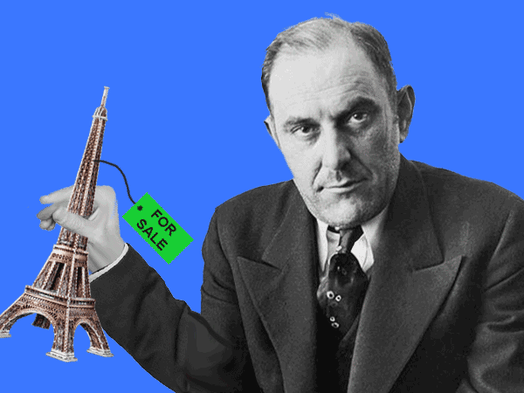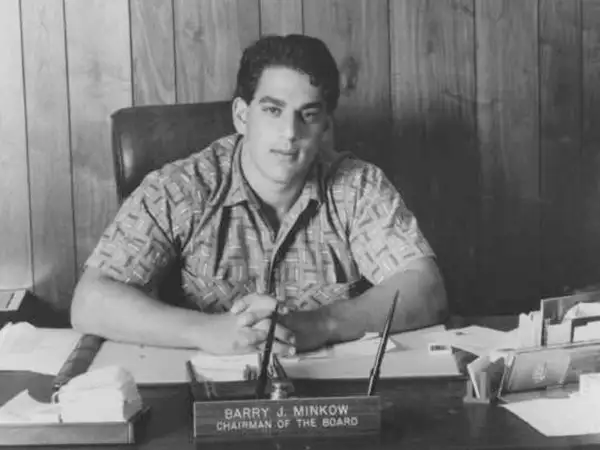Victor Lustig strode the streets of Paris in a slim-fitting suit. Passersby tipped their hats to him as he passed. “Monsieur le Ministre,” they greeted him, respectfully, as Lustig nodded to them in return.

Lustig was short and slight, with ears that protruded with determination from his head. With him was his new friend, businessman André Poisson, and as the men walked together, Lustig pointed out buildings where the French government conducted secret business or maintained bomb shelters.
The pair were in the final stages of making a deal for the Eiffel Tower. For millions of gold francs, Poisson would buy it from the government and disassemble it for scrap. As they walked in the tower’s shadow, Lustig promised Poisson that with just a bit of paperwork, the iconic monument would be his.
Lustig was delivering more than a pitch — he was selling a fantasy. There was just one problem. None of it was real.
Lustig is one of history’s most notorious con men, wanted for schemes across Europe and North America. His most audacious scam? Selling the Eiffel Tower — not once, but twice. How’d he pull it off?
International man of mystery
Victor Lustig, whose name according to officers at Alcatraz was actually Robert Miller, was born in 1890 in the Austrian-Hungarian town of Hostinné, now part of the Czech Republic.
Signs of his talents for bending the truth appeared early, according to Christopher Sandford, author of Victor Lustig: The Man Who Conned the World. In his teens, he adopted aristocratic aliases with titles like Baron and Count.
By 18, he’d moved from pickpocketing to taking victims for a ride at the card tables in Vienna. “He could make a deck of cards do anything but talk,” one victim told True Detective Mysteries magazine.
Lustig (center) was questioned by police in at least five countries. He’d usually talk his way out of the charges. (Photo by Keystone-France/Gamma-Keystone via Getty Images)
Lustig moved around Europe like a pinball, from Vienna to Prague to London and back again. He scammed using a bait-and-switch technique: One woman reported to Parisian police that Lustig had pretended to be a German count who’d come into an inheritance. Could she loan him an advance on the money until he could visit an open bank that Monday?
She agreed, and in exchange took a gold watch he offered as collateral. He vanished, and the watch turned out to be stainless steel in gold paint.
He faked and sold historical documents by reams of famous people, including Marie Curie, the Wright brothers, and Abraham Lincoln. When he went to a magazine office to defend the “newly discovered” Mark Twain story he’d sold them, which the Twain estate was contesting, his defense went so well he also managed to sell them a newly discovered Walt Whitman poem he just happened to have on hand.
Lustig also had a knack for figuring out where the millionaires were hanging out. In 1914, it was around the poker tables of transatlantic ships. He paired up with another passenger, worked out a set of signals, and together they goaded unsuspecting players into going all-in before one of them swept the winnings.
Ever the optimist, Lustig (right) strolled out of court with a twinkle in his eye after receiving a sentence of 20 years in prison. (Photo by Keystone-France/Gamma-Keystone via Getty Images)
His daughter Betty, born in 1922, would later recall that the first words she learned from him weren’t “Mom” or “Dad” but “never speak to the police.”
“He would go through these things that you and I would probably think were career-stopping events, like being arrested,” Sandford says. Lustig would cruise through, viewing them as minor obstacles before returning home to his wife and daughter. “He just didn’t have the moral stop sign.”
‘Barbaric bulk’
By the time Lustig made it to Paris in 1925, the Eiffel Tower was 38 years old. Parisians hated it. Initially constructed for the World Fair, principal engineer Gustave Eiffel had to put up most of the 7.8m gold francs (or 32m euros today) himself to build it.
A petition sent to the government after it went up called it a “barbaric bulk” and “a ghastly dream.” Writer Guy de Maupassant called it a “lanky pyramid” that should be smashed. Despite the pushback and the tower needing some 60 tons of paint every seven years to maintain it, it stayed up.
The Hustle
Lustig came to Paris prepared to make the play of his career. He’d been following the furor about the tower, which had become a rusting eyesore, and had seen speculation in the newspapers about the government wanting to tear it down. It gave him an idea. He’d toyed with phony real estate scams before — once selling the Tower Bridge in London — but this would be a much bigger challenge and a much bigger reward. It would be a true test of his gift for salesmanship.
He took a room at the upscale Hotel de Crillon, and paid off the staff to let him transform a basement storage room into an office fit for conducting clandestine state business. He had an accomplice date a woman who worked for the government to acquire official letterhead, then sent letters to the city’s most prominent manufacturing businessmen.
The meetings began. One by one, they came to the Crillon, where Lustig introduced himself as deputy director general of the ministère de postes et télégraphes, and explained that the government was planning to sell off the tower as scrap metal. Discretion was crucial: It would be a controversial decision.
One man, in particular, caught Lustig’s eye. André Poisson was a newcomer to Paris, eager to make his mark on the city.
The pair became fast friends: Lustig’s accomplices recalled seeing them laughing together in the Crillon lobby. When Lustig was called away on urgent government business to Bordeaux, he brought Poisson along.
A few weeks later, Poisson signed a contract outlining the terms: He’d pay 1.2m francs (or 4.2m euros today), and the tower would be his to dispose of. That’s when Lustig played his final card: He asked Poisson for a bribe to grease the wheels of his lowly life as a mere government employee. He turned over a check for the tower, and paid the bribe in cash.
Poisson later said that was what made Lustig so believable — he knew how corrupt the government really was. Poisson paid an additional 70k francs for the bribe, or 200k euros today, and by the time he realized he’d been had, Lustig was back in Vienna.
Poisson was too embarrassed to alert the police.
In 1925, the same year Lustig pulled his scam, the Eiffel Tower also became the world’s most iconic billboard for auto maker Citroen. (Photo by Boyer/Roger Viollet via Getty Images)
When Lustig suggested selling the tower again to his accomplices the following month, they thought he was crazy. Still, they sought out another handful of scrap dealers, and set about making the same play.
“In many ways, he was a charming rogue,” Sandford says.
After his second mark suspected he’d been scammed, he called the police. This time, news of the scam hit the papers.
Lustig thought it best to end his dance with Parisian fate there. He skipped town more permanently, and moved his wife and daughter to the Chicago suburbs.
Monumental scams
In the early 1900s, the heyday of one Charles Ponzi, phony real estate scams were popular. It was also the heyday of selling historical monuments the salesman didn’t own.
Lustig probably didn’t dream up his Eiffel Tower scam. He was likely influenced by fraudsters like George Parker, who repeatedly sold off the Brooklyn Bridge, the Statue of Liberty, and the Met.
The Hustle
It wasn’t the Eiffel Tower scam that did him in, though. Lustig would go on to swindle legendary gangster Al Capone and build a million-dollar counterfeiting business before Secret Service agents hauled him in for good for sending tens of thousands of fake $100 bills into the economy. (Lustig’s aggrieved mistress tipped them off to his whereabouts.)
By then, he’d grown so adept at the art of the con that he developed a set of rules for other fraudsters to use as a guide, including:
- Be a patient listener
- Never look bored, never get drunk
- Wait for the other person to reveal any political opinions, then agree with them
- Never boast; just let your importance be quietly obvious
Lustig was sentenced to 20 years in Alcatraz and served 14 of them before he died. According to Sandford, Lustig was working on one more skill to add to his repertoire before his death: repentance.
He’d started to meet with the prison chaplain, and expressed curiosity about religion for the first time in his life.
“We just don’t know whether this was yet another scam,” Sandford says. “Whether he was playing the minister and whether, ultimately, he might have walked out of Alcatraz disguised as the minister, leaving the minister himself tied up somewhere.”
Still, there are lessons to be learned from Lustig, if only cautionary ones. Despite the horror stories and warnings, the examples of fraudsters across the centuries, people are still just as gullible as Poisson.
“He proved time and again that you have a plausible story, a certain charm, and in his case the willingness to play the long game, and you can appeal to the part of us that wants to feel appreciated,” Sandford says. “He knew what people wanted to hear.”
One more thing we can learn from the Lustigs of the world? The more things change, the more scams stay the same.
Fraud And Scams




